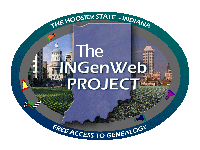Fountain Poor Farm - Beckwith History
Source: History of Fountain County, Indiana. H.W. Beckwith. Chicago: HH Hill, 1881, p 69
Asylum for the poor – How to provide for its poor is always a question of perplexing difficulty for any state or community to answer. This question had occupied the attention of the greatest and best men and women in all ages from the very earliest period. Alms-giving was at an early period of the world’s history, inculcated as a religious observance. Among the Greeks it was provided that those who were maimed in battle should be supported at public expense and in the legislation of all modern counties laws for the relief of the poor have a conspicuous place. The duty of providing for the helpless poor has never been disputed hut the difficulty has been to distinguish between the poor who would maintain themselves if they could and the poor who could maintain themselves if they would and to found public charities so that they will be efficient in relieving the deserving poor and yet not destructive of the independence industry integrity and domestic virtue which is as necessary to one condition of life as another. The most sensible idea seems to be that which makes relief, in all cases where there is ability to work, temporary and to cease as soon as the recipient of the charity can be put in a position to support himself; effort being made in the meantime to find employment for all who are able too work. There is but little doubt that the ordinary county asylum is as often the home of the voluntary mendicant as of him whose necessities and misfortunes compel him to seek its shelter. The idle and vicious as frequently find a retreat there as the unfortunate. It is therefore no place for the children who have become wards of the state through poverty to be brought up in. These ought to be provided with the education and training to fit them for lives of usefulness and not left to grow up in an atmosphere of idleness and pauperism to become themselves idlers and paupers and the progenitors of idlers and paupers. Pity and charity are the noblest of emotions and misfortune always appeals to both and its appeal ought never to be in vain; but that is the truest help which puts the unfortunate in the way of helping himself and it is the help which will be most grateful to the deserving poor, for while it relieves their necessities it preserved their independence. There is but very little to be said of the public buildings erected for the relief of the poor in this county. the first house was completed in March 1837 and there is nothing of record to indicate its size or cost; but it is known that it was a very plain and inexpensive building which stood northeast from Covington about two miles. In 1862 or 1863 the county became the purchaser of the present farm occupied by it, lying three miles north of Covington; and in 1863 the contract for building the asylum now standing thereon was let to Nathaniel Morgan of Crawfordsville for $8,700. The house is well and substantially built and will be sufficient to meet the wants of the county for a long time to come. The only other building the county ever owned which needs to be mentioned was the county seminary built under the law of 1843 providing for the erection of a county seminary in each county of the state. This law took effect in 1843 and in June 1844 the board of commissioners appointed John Hamilton, Benedict Morris and William Hoffman a committee to “superintend the building of a county seminary,” with power to adopt a plan for the same. The committee adopted a plan and the contract was let to Wm. S. Patterson and John Billsland, their bid being $1,064.08. The county seminary plan was a failure and this build was, until it burnt down used for the common schools of Covington.


